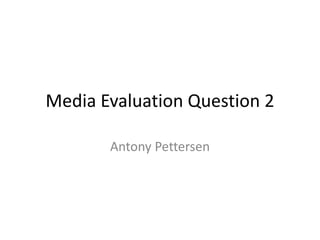
Representing Social Groups in Media
- 1. Media Evaluation Question 2 Antony Pettersen
- 2. How does your media product represent particular social groups?
- 3. What is representation in media? As defined from http://www.mediaknowall.com/as_alevel/alevkeyconcepts/alevelkeycon.php?pageID=represent representation in media is: “By definition, all media texts are re-presentations of reality. This means that they are intentionally composed, lit, written, framed, cropped, captioned, branded, targeted and censored by their producers, and that they are entirely artificial versions of the reality we perceive around us. When studying the media it is vital to remember this - every media form, from a home video to a glossy magazine, is a representation of someone's concept of existence, codified into a series of signs and symbols which can be read by an audience. However, it is important to note that without the media, our perception of reality would be very limited, and that we, as an audience, need these artificial texts to mediate our view of the world, in other words we need the media to make sense of reality. Therefore representation is a fluid, two-way process: producers position a text somewhere in relation to reality and audiences assess a text on its relationship to reality. “
- 4. What is representation in media? This is http://www.medienabc.org/page5/page19/page19.html view on representation: “The media constructs views of the real world for us to read and interpret. These views having been mediated provide filtered and partial meanings. However we mostly ignore this selection and often fail to question the language and images that are used. Like wallpaper they are just there; as Athusser suggested ideologies happen behind our backs. In order for our students to begin to see behind their backs we need to show them how such meanings are constructed to appear 'natural'. The issue of realism therefore is linked to representation. Do we accept the producers' views of reality? Can audiences read in differentiated ways to judge realism? Can discourses around representations change? Representations of others can have a fundamental effect not only on personal behaviour but also on political and global events. Terrorism and immigration continue to be huge issues. The success of media texts depends upon their apparent naturalness; we turn off a production that looks “fake.” But the truth is, it’s all fake – even the news! That doesn’t mean we can’t still enjoy a movie, watch TV or listen to music. The goal of this question is not to make us cynical but simply to expose the complexities of media’s “constructedness” and thus create the critical distance we need to be able to ask other important questions. 2003 Center for Media Literacy / www.medialit.org Literacy for the 21stCentury/ Orientation & Overview”
- 5. Summary In summary of this: All media is in a way orchestrated to show the views of certain high power individuals. Media products are “fake” but rely on their element of realism Media products work two ways with the content being dictated by producers whilst the reader assesses the work in relationship to reality This all equates to the fact that representation is important in media because: 1. It helps us create a perceived view of the world and gives us a wide variety of knowledge. 2. Media controls how we view the world through point 1
- 6. How have you represented Gender? In my music magazine through the use of images I have only used male models. This can be seen as confirmative or challenging depending on how you wish to construct opinion because some magazine feature heavily or exclusive one gender of model whilst others have a mix or use mixed gender models. All male is a deliberate choice for this first issue. The representation of the male gender in my magazine is positive due to the photos not being intimidating and having a slight use of humour. Also they look very accessible due to them looking normal meaning the average reader can relate to them. This suggests the content is all about the music not about the person behind it.
- 7. How have you represented Age? Due to this magazine being targeted at young to- middle aged audience meaning that there is quite a large age ranged. Also the magazines house style and name of “vinyl” implies its older target audience due to the use of old technology. Although the pictures are of young adults there is a sense of maturity around the magazine helping the gearing towards a middle aged audience.
- 8. Deliberate exclusion of certain groups I have deliberate excluded females from the first issue of my magazine due to the style of music I want to feature being prominently dominated by males. Also due to my magazine being prominently about music I feel the target audience will appreciate. Despite the exclusion of female there hasn’t been any exclusion of different subcultures from the target music genre of the magazine due to the magazine being all about the music and not about style of image.